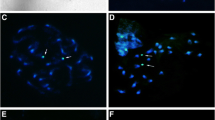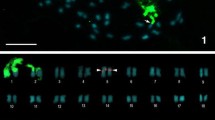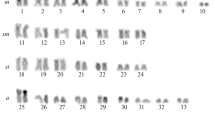Abstract.
The genus Hypochaeris (Asteraceae, Lactuceae) contains ten species in Europe, three in Asia, and approximately 50 in South America. Previous cytotaxonomic studies have shown two groups of taxa: (1) European species with different basic chromosome numbers and differentiated karyotypes, and (2) South American species with x=4 and uniform asymmetric and bimodal karyotypes. Karyotypic data are synthesized for South American species of Hypochaeris with new information for six Chilean species: H. acaulis, H. apargioides, H. palustris, H. spathulata, H. tenuifolia and H. thrincioides. Four main groups can be distinguished based on presence and localization of secondary constrictions – SCs (bearing Nucleolar Organizer Regions – NORs) on chromosomes 2 and 3, and 18S–25S and 5S rDNA loci number, localization, and activity. We propose karyotypic evolution of South American Hypochaeris (x=4) from H. maculata-like (x=5) European ancestors. The original South American karyotype would have possessed two SCs, one on the long arm of chromosome 2, and the other on the short arm of chromosome 3 (in terminal position). Further evolution would have involved inversion within the short arm of chromosome 3 and inactivation/loss of the SC on chromosome 2.
Similar content being viewed by others
Author information
Authors and Affiliations
Corresponding author
Rights and permissions
About this article
Cite this article
Weiss-Schneeweiss, H., Stuessy, T., Siljak-Yakovlev, S. et al. Karyotype evolution in South American species of Hypochaeris (Asteraceae, Lactuceae). Plant Syst. Evol. 241, 171–184 (2003). https://doi.org/10.1007/s00606-003-0026-x
Received:
Published:
Issue Date:
DOI: https://doi.org/10.1007/s00606-003-0026-x




